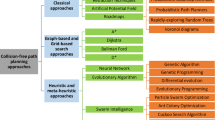Abstract
The behavior based approach has been actively used in many applications of intelligent robots due to the advantages of dividing the control system according to the task achieving behaviors over the conventional method in which the division is based on functions. One important application that had been done is for a mobile robot to reach a target while avoiding obstacles. The objective of this paper is for a multi-link manipulator to reach a target while avoiding obstacles by using a fuzzy behavior-based control approach. The control system that had been applied to the mobile robot in the previous work, is modified to suit to the manipulator. Fuzzy behavior elements are trained by a genetic algorithm. An additional component is also introduced in order to overcome the gravitational effect. Simulation results show that the manipulator reaches the target with an acceptable solution.
Preview
Unable to display preview. Download preview PDF.
Similar content being viewed by others
References
Brooks, R.A.: A Robust Layered Control Systems for a Mobile Robot. IEEE Journal of Robotics and Automation 2(1), 14–23 (1986)
Maes, P.: Learning Behavior Networks from Experience. In: Procs. of the First European Conference on Artificial Life, pp. 48–57 (1992)
Koza, J.R.: Evolution of Subsumption Using Genetic Programming. In: Procs. of the First European Conference on Artificial Life, pp. 110–119 (1992)
Watanabe, K., Izumi, K.: Construction of Fuzzy Behavior-Based Control Systems for a Mobile robot. In: Procs. of the Third Int. Symposium on Artificial Life and Robotics (AROB 3rd 1998), vol. 2, pp. 518–523 (1998)
Watanabe, K., Izumi, K.: A Fuzzy Neural Realization of Behavior-Based Control System for a Mobile Robot. In: Jain, L.C., Fukuda, T. (eds.) Soft Computing for Intelligent Robotics Systems, pp. 1–26. Physica-Verlag, Heidelberg (1998)
Watanabe, K., Izumi, K.: Fuzzy Behavior-Based Control for an Omnidirectional Mobile Robot. In: Procs. of the Third Int. Symposium on Artificial Life and Robotics (AROB 3rd 1998), vol. 2, pp. 524–527 (1998)
Rahmanian-shahri, N., Troch, I.: Collision-Avoidance for Redundant Robots through Control of the Self-Motion of the Manipulator. J. of Intelligent and Robotic Systems 16(2), 123–149 (1996)
Ding, H., Chan, S.P.: A Real-Time Planning Algorithm for Obstacle Avoidance of Redundant Robots. J. of Intelligent and Robotic Systems 16(3), 229–243 (1996)
Nearchou, A.C., Aspragathos, N.A.: Collision-Free Cartesian Trajectory Generation using Raster Scanning and Genetic Algorithms. J. of Intelligent and Robotic Systems 23(2-4), 351–377 (1998)
Craig, J.J.: Introduction to Robotics: Mechanics and Control, pp. 179–180. Addison-Wesley, Reading (1989)
Fu, K.S., Gonazalez, R.C., Lee, C.S.G.: Robotics, Control, Sensing, Vision, and Intelligence, pp. 103–118. McGraw-Hill, New York (1987)
Author information
Authors and Affiliations
Editor information
Editors and Affiliations
Rights and permissions
Copyright information
© 1999 Springer-Verlag Berlin Heidelberg
About this paper
Cite this paper
Dassanayake, P., Watanabe, K., Izumi, K. (1999). Fuzzy Behavior-Based Control for the Obstacle Avoidance of Multi-link Manipulators. In: Zhong, N., Skowron, A., Ohsuga, S. (eds) New Directions in Rough Sets, Data Mining, and Granular-Soft Computing. RSFDGrC 1999. Lecture Notes in Computer Science(), vol 1711. Springer, Berlin, Heidelberg. https://doi.org/10.1007/978-3-540-48061-7_31
Download citation
DOI: https://doi.org/10.1007/978-3-540-48061-7_31
Publisher Name: Springer, Berlin, Heidelberg
Print ISBN: 978-3-540-66645-5
Online ISBN: 978-3-540-48061-7
eBook Packages: Springer Book Archive




